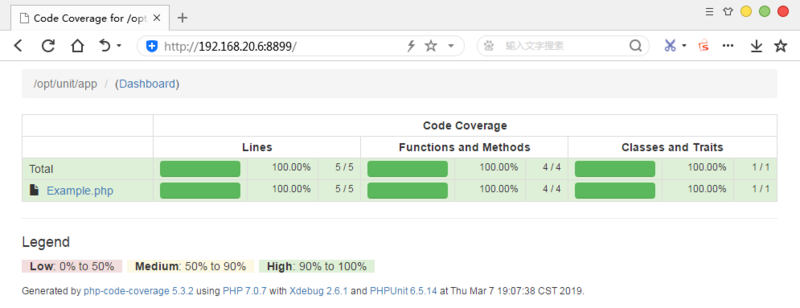PHPUnit单元测试生成代码覆盖率 使用PHPUnit进行单元测试并生成代码覆盖率报告的方法
big_cat 人气:0安装PHPUnit
使用 Composer 安装 PHPUnit
#查看composer的全局bin目录 将其加入系统 path 路径 方便后续直接运行安装的命令 composer global config bin-dir --absolute #全局安装 phpunit composer global require --dev phpunit/phpunit #查看版本 phpunit --version
使用Composer构建你的项目
我们将新建一个unit项目用于演示单元测试的基本工作流
创建项目结构
mkdir unit && cd unit && mkdir app tests reports #结构如下 ./ ├── app #存放业务代码 ├── reports #存放覆盖率报告 └── tests #存放单元测试
使用Composer构建工程
#一路回车即可
composer init
#注册命名空间
vi composer.json
...
"autoload": {
"psr-4": {
"App\\": "app/",
"Tests\\": "tests/"
}
}
...
#更新命名空间
composer dump-autoload
#安装 phpunit 组件库
composer require --dev phpunit/phpunit
到此我们就完成项目框架的构建,下面开始写业务和测试用例。
编写测试用例
创建文件app/Example.php 这里我为节省排版就不写注释了
<?php
namespace App;
class Example
{
private $msg = "hello world";
public function getTrue()
{
return true;
}
public function getFalse()
{
return false;
}
public function setMsg($value)
{
$this->msg = $value;
}
public function getMsg()
{
return $this->msg;
}
}
创建相应的测试文件tests/ExampleTest.php
<?php
namespace Tests;
use PHPUnit\Framework\TestCase as BaseTestCase;
use App\Example;
class ExampleTest extends BaseTestCase
{
public function testGetTrue()
{
$example = new Example();
$result = $example->getTrue();
$this->assertTrue($result);
}
public function testGetFalse()
{
$example = new Example();
$result = $example->getFalse();
$this->assertFalse($result);
}
public function testGetMsg()
{
$example = new Example();
$result = $example->getTrue();
// $result is world not big_cat
$this->assertEquals($result, "hello big_cat");
}
}
执行单元测试
[root@localhost unit]# phpunit --bootstrap=vendor/autoload.php \ tests/ PHPUnit 6.5.14 by Sebastian Bergmann and contributors. ..F 3 / 3 (100%) Time: 61 ms, Memory: 4.00MB There was 1 failure: 1) Tests\ExampleTest::testGetMsg Failed asserting that 'hello big_cat' matches expected true. /opt/unit/tests/ExampleTest.php:27 /root/.config/composer/vendor/phpunit/phpunit/src/TextUI/Command.php:195 /root/.config/composer/vendor/phpunit/phpunit/src/TextUI/Command.php:148 FAILURES! Tests: 3, Assertions: 3, Failures: 1.
这是一个非常简单的测试用例类,可以看到,执行了共3个测试用例,共3个断言,共1个失败,可以参照PHPUnit手册学习更多高级用法。
代码覆盖率
代码覆盖率反应的是测试用例对测试对象的行,函数/方法,类/特质的访问率是多少(PHP_CodeCoverage 尚不支持 Opcode覆盖率、分支覆盖率 及 路径覆盖率),虽然有很多人认为过分看重覆盖率是不对的,但我们初入测试还是俗气的追求一下吧。
测试覆盖率的检测对象是我们的业务代码,PHPUnit通过检测我们编写的测试用例调用了哪些函数,哪些类,哪些方法,每一个控制流程是否都执行了一遍来计算覆盖率。
PHPUnit 的覆盖率依赖 Xdebug,可以生成多种格式:
--coverage-clover <file> Generate code coverage report in Clover XML format. --coverage-crap4j <file> Generate code coverage report in Crap4J XML format. --coverage-html <dir> Generate code coverage report in HTML format. --coverage-php <file> Export PHP_CodeCoverage object to file. --coverage-text=<file> Generate code coverage report in text format. --coverage-xml <dir> Generate code coverage report in PHPUnit XML format.
同时需要使用 --whitelist dir参数来设定我们需要检测覆盖率的业务代码路径,下面演示一下具体操作:
phpunit \ --bootstrap vendor/autoload.php \ --coverage-html=reports/ \ --whitelist app/ \ tests/ #查看覆盖率报告 cd reports/ && php -S 0.0.0.0:8899


这样我们就对业务代码App\Example做单元测试,并且获得我们单元测试的代码覆盖率,现在自然是百分之百,因为我的测试用例已经访问了App\Example的所有方法,没有遗漏的,开发中则能体现出你的测试时用力对业务代码测试度的完善性。
基境共享测试数据
可能你会发现我们在每个测试方法中都创建了App\Example对象,在一些场景下是重复劳动,为什么不能只创建一次然后供其他测试方法访问呢?这需要理解 PHPUnit 执行测试用例的工作流程。
我们没有办法在不同的测试方法中通过某成员属性来传递数据,因为每个测试方法的执行都是新建一个测试类对象,然后调用相应的测试方法。
即测试的执行模式并不是
testObj = new ExampleTest(); testObj->testMethod1(); testObj->testMethod2();
而是
testObj1 = new ExampleTest(); testObj1->testMethod1(); testObj2 = new ExampleTest(); testObj2->testMethod2();
所以testMethod1()修改的属性状态无法传递给 testMethod2()使用。
PHPUnit则为我们提供了全面的hook接口:
public static function setUpBeforeClass()/tearDownAfterClass()//测试类构建/解构时调用 protected function setUp()/tearDown()//测试方法执行前/后调用 protected function assertPreConditions()/assertPostConditions()//断言前/后调用
当运行测试时,每个测试类大致就是如下的执行步骤
#测试类基境构建 setUpBeforeClass #new一个测试类对象 #第一个测试用例 setUp assertPreConditions assertPostConditions tearDown #new一个测试类对象 #第二个测试用例 setUp assertPreConditions assertPostConditions tearDown ... #测试类基境解构 tearDownAfterClass
所以我们可以在测试类构建时使用setUpBeforeClass创建一个 App\Example 对象作为测试类的静态成员变量(tearDownAfterClass主要用于一些资源清理,比如关闭文件,数据库连接),然后让每一个测试方法用例使用它:
<?php
namespace Tests;
use App\Example;
use PHPUnit\Framework\TestCase as BaseTestCase;
class ExampleTest extends BaseTestCase
{
// 类静态属性
private static $example;
public static function setUpBeforeClass()
{
self::$example = new Example();
}
public function testGetTrue()
{
// 类的静态属性更新
self::$example->setMsg("hello big_cat");
$result = self::$example->getTrue();
$this->assertTrue($result);
}
public function testGetFalse()
{
$result = self::$example->getFalse();
$this->assertFalse($result);
}
/**
* 依赖 testGetTrue 执行完毕
* @depends testGetTrue
* @return [type] [description]
*/
public function testGetMsg()
{
$result = self::$example->getMsg();
$this->assertEquals($result, "hello big_cat");
}
}
或者使用@depends注解来声明二者的执行顺序,并使用传递参数的方式来满足需求。
public function testMethod1()
{
$this->assertTrue(true);
return "hello";
}
/**
* @depends testMethod1
*/
public function testMethod2($str)
{
$this->assertEquals("hello", $str);
}
#执行模式大概如下 testObj1 = new Test; $str = testObj1->testMethod1(); testObj2 = new Test; testObj2->testMethod2($str);
理解测试执行的模式还是很有帮助的,其他高级特性请浏览官方文档。
使用phpunit.xml编排测试套件
使用测试套件来管理测试,vi phpunit.xml:
<?xml version="1.0" encoding="UTF-8"?>
<phpunit backupGlobals="false"
backupStaticAttributes="false"
bootstrap="./vendor/autoload.php"
colors="true"
convertErrorsToExceptions="true"
convertNoticesToExceptions="true"
convertWarningsToExceptions="true"
processIsolation="false"
stopOnFailure="false">
<testsuites>
<!--可以定义多个 suffix 用于指定待执行的测试类文件后缀-->
<testsuite name="Tests">
<directory suffix="Test.php">./test</directory>
</testsuite>
</testsuites>
<filter>
<whitelist processUncoveredFilesFromWhitelist="true">
<!--可以定义多个 对./app下的业务代码做覆盖率统计-->
<directory suffix=".php">./app</directory>
</whitelist>
</filter>
<logging>
<!--覆盖率报告生成类型和输出目录 lowUpperBound低覆盖率阈值 highLowerBound高覆盖率阈值-->
<log type="coverage-html" target="./reports" lowUpperBound="35" highLowerBound="70"/>
</logging>
</phpunit>
然后直接运phpunit行即可:
[root@localhost unit]# phpunit PHPUnit 6.5.14 by Sebastian Bergmann and contributors. Time: 81 ms, Memory: 4.00MB No tests executed! Generating code coverage report in HTML format ... done
加载全部内容